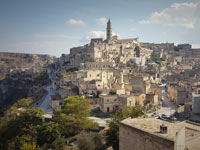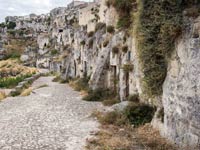Russia, 199034, St. Petersburg, Line 14th V.O., house 7, letter A, BC "Preobrazhensky"

(812) 322-09-40
(812) 322-34-40
Matera is a city of limestone
In the south of Italy, in the region of Basilicata, there is an amazing, small and beautiful city, a UNESCO World Heritage Site, a favorite place of cinematographers, a cave city, the legendary city of Matera. It is proved that this place was inhabited more than 7,000 years ago. However, the official history dates back to the 3rd century BC. The terrain, by its nature, consisting of many grottoes, catacombs, caves, predetermined its history. In the ancient, historical part of this city, all the dwellings were either located in “ready-made” caves, or were cut down in limestone rocks, or rather in calcareous, trimmed or built from the same stone. So that often on the roof of one house there is another, or a road passes! Italians themselves write about these places that the local stone is a soft tuff, which here is called Gravinian Calcareous, which in turn is a type of limestone (limestone sandstone or detrital limestone).
The rocky facades of Matera "Sassi di Matera", translated from Italian "stones of Matera" - the most ancient, historical part of the city - is considered one of the first settlements in modern Italy, and in general one of the oldest settlements on earth, where life has not been interrupted for thousands of years . Many stairs, many stone steps and roads link the different levels of this limestone city to each other. And also - a lot of wells, trenches, reservoirs for collecting water. Residents of the city did everything possible and impossible to collect rainwater. For this purpose, a whole system of internal drainage was developed, along which each precious drop fell into the house, in a specially designated place.







 Site search
Site search



